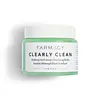What's inside
What's inside
 Key Ingredients
Key Ingredients

 Benefits
Benefits

 Concerns
Concerns

 Ingredients Side-by-side
Ingredients Side-by-side

Ethylhexyl Palmitate
EmollientCetearyl Alcohol
EmollientPolysorbate 60
EmulsifyingHelianthus Annuus Seed Oil
EmollientPEG-20 Glyceryl Triisostearate
EmollientWater
Skin ConditioningOryza Sativa Bran Wax
Skin ConditioningCopernicia Cerifera Wax
PEG-40 Hydrogenated Castor Oil
EmulsifyingHydrogenated Soybean Oil
EmollientHydrogenated Soy Polyglycerides
Skin ConditioningC15-23 Alkane
SolventGlyceryl Stearate
EmollientSilica
AbrasiveEthylene/Propylene Copolymer
AbrasiveSynthetic Wax
AbrasiveTocopheryl Acetate
AntioxidantGarcinia Indica Seed Butter
Skin ConditioningCoco-Glucoside
CleansingPentaerythrityl Tetra-Di-T-Butyl Hydroxyhydrocinnamate
AntioxidantCI 26100
Cosmetic ColorantArgania Spinosa Kernel Oil
EmollientPhenoxyethanol
PreservativeEthylhexylglycerin
Skin ConditioningParfum
MaskingEthylhexyl Palmitate, Cetearyl Alcohol, Polysorbate 60, Helianthus Annuus Seed Oil, PEG-20 Glyceryl Triisostearate, Water, Oryza Sativa Bran Wax, Copernicia Cerifera Wax, PEG-40 Hydrogenated Castor Oil, Hydrogenated Soybean Oil, Hydrogenated Soy Polyglycerides, C15-23 Alkane, Glyceryl Stearate, Silica, Ethylene/Propylene Copolymer, Synthetic Wax, Tocopheryl Acetate, Garcinia Indica Seed Butter, Coco-Glucoside, Pentaerythrityl Tetra-Di-T-Butyl Hydroxyhydrocinnamate, CI 26100, Argania Spinosa Kernel Oil, Phenoxyethanol, Ethylhexylglycerin, Parfum
Cetyl Ethylhexanoate
EmollientSynthetic Wax
AbrasiveCoco-Caprylate/Caprate
EmollientCaprylic/Capric Triglyceride
MaskingPolyglyceryl-10 Dioleate
EmulsifyingPolyglyceryl-6 Dicaprate
EmulsifyingSorbitan Oleate Decylglucoside Crosspolymer
CleansingHelianthus Annuus Seed Oil
EmollientMoringa Oleifera Seed Extract
Skin ConditioningCarica Papaya Fruit Extract
Skin ConditioningMoringa Oleifera Leaf Water
Skin ConditioningPentylene Glycol
Skin ConditioningGluconolactone
Skin ConditioningPolyglyceryl-6 Oleate
EmulsifyingGlyceryl Citrate/Lactate/Linoleate/Oleate
EmulsifyingSorbitan Sesquioleate
EmulsifyingPotassium Olivate
EmulsifyingGlyceryl Caprylate
EmollientPolyglyceryl-3 Caprate
EmulsifyingPolyglyceryl-4 Cocoate
EmollientSodium Chloride
MaskingButylene Glycol
HumectantWater
Skin ConditioningSodium Benzoate
MaskingMaltodextrin
AbsorbentGlyceryl Laurate
EmollientCetyl Ethylhexanoate, Synthetic Wax, Coco-Caprylate/Caprate, Caprylic/Capric Triglyceride, Polyglyceryl-10 Dioleate, Polyglyceryl-6 Dicaprate, Sorbitan Oleate Decylglucoside Crosspolymer, Helianthus Annuus Seed Oil, Moringa Oleifera Seed Extract, Carica Papaya Fruit Extract, Moringa Oleifera Leaf Water, Pentylene Glycol, Gluconolactone, Polyglyceryl-6 Oleate, Glyceryl Citrate/Lactate/Linoleate/Oleate, Sorbitan Sesquioleate, Potassium Olivate, Glyceryl Caprylate, Polyglyceryl-3 Caprate, Polyglyceryl-4 Cocoate, Sodium Chloride, Butylene Glycol, Water, Sodium Benzoate, Maltodextrin, Glyceryl Laurate
 Reviews
Reviews

Alternatives
Ingredients Explained
These ingredients are found in both products.
Ingredients higher up in an ingredient list are typically present in a larger amount.
Helianthus Annuus Seed Oil is the oil derived from the seeds of a Sunflower. Sunflower seed oil is non-fragrant. It is an emollient, meaning it helps to soften the skin.
Sunflower seed oil contains many fatty acids. The fatty acids found in sunflower seeds include (from highest amount to least): linoleic acid, myristic acid, palmitic acid, stearic acid, arachidic acid, oleic acid, and linolenic acid.
These fatty acids help the skin create ceramides. Ceramides play a role in repairing the skin barrier.
Helianthus Annuus Seed Oil helps moisturize the skin. This in turn helps the skin look more rejuvenated and smoother.
Sunflowers are rich in vitamin E.
Historians believe Indigenous cultures of North America domesticated sunflowers before corn. Thus they relied on sunflower oil for a variety of uses. One such use is moisturizing skin and hair.
Sunflower seed oil may not be fungal acne safe. We recommend speaking with a professional if you have any concerns.
Learn more about Helianthus Annuus Seed OilSynthetic Wax is created from fossil fuels such as natural gas. It is used to enhance texture, adjust pH, and as an occlusive.
It may also be used as an abrasive ingredient to exfoliate the skin.
Synthetic Wax may not be fungal acne safe.
Learn more about Synthetic WaxWater. It's the most common cosmetic ingredient of all. You'll usually see it at the top of ingredient lists, meaning that it makes up the largest part of the product.
So why is it so popular? Water most often acts as a solvent - this means that it helps dissolve other ingredients into the formulation.
You'll also recognize water as that liquid we all need to stay alive. If you see this, drink a glass of water. Stay hydrated!
Learn more about Water